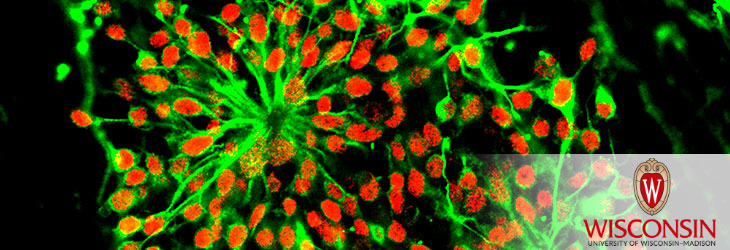Pluripotent Stem Cells

Xenogen-Free Culture Medium for Stem Cells
WARF: P130178US02
Inventors: Igor Slukvin, Gene Uenishi
The Wisconsin Alumni Research Foundation (WARF) is seeking commercial partners interested in developing a method to differentiate human pluripotent stem cells to endothelial and blood lineage cells using serum- and xenogen-free medium.
Overview
With the advent of human pluripotent stem cell technologies, endothelial and blood lineage (hematopoietic) cells can be produced in vitro for functional studies and therapies. Efficient differentiation of these cells has traditionally relied on co-culture with mouse stromal cells such as OP9, and the use of serum or non-human (xenogenic) protein-containing media.
However, such culture systems have limited utility for studying stem cell response to specific growth factors and they constrict the manufacture of clinical grade therapeutic blood cells.
Given these shortcomings, a new culture system is needed that avoids non-human contamination risks and can provide endothelial/blood lineage cells suitable for clinical applications.
However, such culture systems have limited utility for studying stem cell response to specific growth factors and they constrict the manufacture of clinical grade therapeutic blood cells.
Given these shortcomings, a new culture system is needed that avoids non-human contamination risks and can provide endothelial/blood lineage cells suitable for clinical applications.
The Invention
UW–Madison researchers have developed a chemically defined, xenogen-free culture system for differentiating human pluripotent stem cells into mesoderm, endothelial and hematopoietic progenitor cells. The new culture system can be used to produce these types of cells from human pluripotent stem cells growing in completely defined E8 medium, thus providing an opportunity to manufacture clinical grade cells.
In the new method, the stem cells (human embryonic or human induced pluripotent stem cells) are seeded as a single cell suspension on a substrate comprising a layer of Tenascin C and IF9S culture medium supplemented with BMP4, Activin A, FGF2 and LiCl. The medium also comprises various hematopoietic cytokines. The stem cells are exposed to the mixture under hypoxic conditions for about two days.
In the new method, the stem cells (human embryonic or human induced pluripotent stem cells) are seeded as a single cell suspension on a substrate comprising a layer of Tenascin C and IF9S culture medium supplemented with BMP4, Activin A, FGF2 and LiCl. The medium also comprises various hematopoietic cytokines. The stem cells are exposed to the mixture under hypoxic conditions for about two days.
Applications
- Differentiating human pluripotent stem cells (hESC or HiPSC)
- Providing endothelial and hematopoietic cell populations
- Functional studies and clinical therapy
Key Benefits
- Chemically defined and serum free
- Cells not exposed to non-human constituents
- As effective as OP9 protocols
- Avoids embryoid body formation
Stage of Development
The researchers have defined the factors and concentrations required to replace OP9 co-culture methods.
Additional Information
For More Information About the Inventors
Related Technologies
Tech Fields
For current licensing status, please contact Andy DeTienne at [javascript protected email address] or 608-960-9857